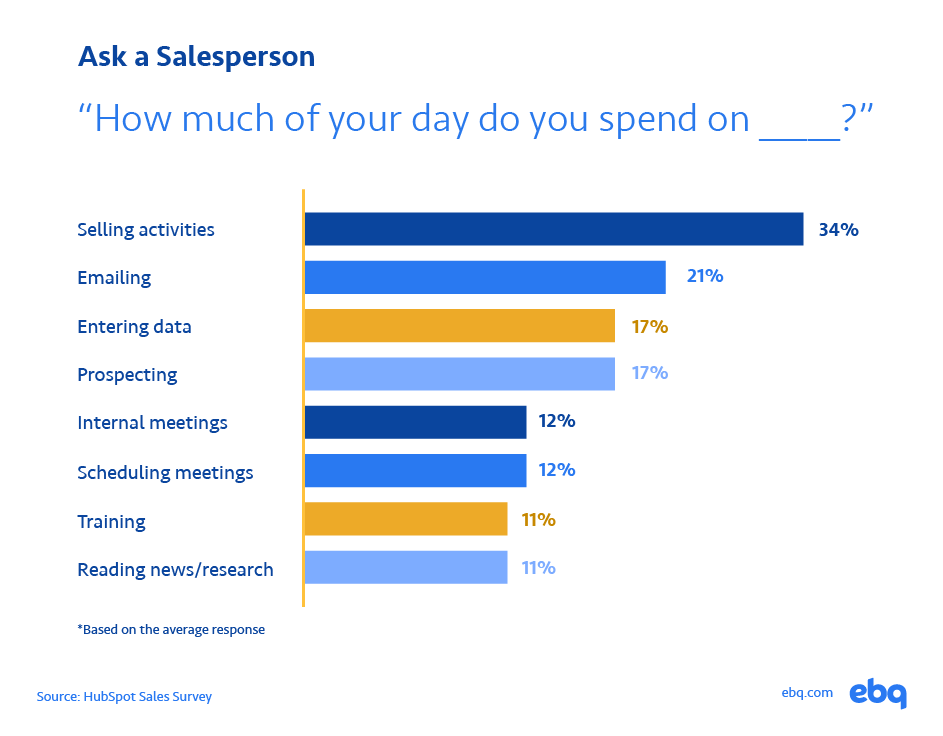7 Biggest B2B Sales Challenges + How to Overcome Them


Tim Edwards
This post was originally published in July 2022 and has been updated for accuracy and comprehensiveness.
According to a recent HubSpot report, the average B2B buyer committee has five people in every sale. This means that your sales team must navigate various hurdles to close a deal. So what are the most common sales challenges and how would you overcome them?
In our 16+ years of experience, we can tell you that the 7 biggest B2B sales challenges are:
- Building a sales team
- Undergoing a long sales cycle
- Aligning marketing and sales
- Establishing brand authority
- Prioritizing salespeople’s limited-time
- Getting to decision-makers
- Handling sales objections
But first, let’s start by discussing the biggest differences between B2B and B2C sales.

Download the Ultimate B2B Appointment Setting Guide
Learn what it takes to identify prospects, get in touch with decision-makers, and set more meetings for your sales reps.
Key Differences Between B2B vs B2C Sales
While B2B and B2C sales require persistence and a full understanding of your buyer persona, they also present their unique differences.

- Selling to an average of five decision-makers (*)
- Long sales cycle (an average of weeks to months)
- High Average Sales Price (ASP)
- Reliance on multiple follow-up attempts using a proven sales cadence
- Require more experienced salespeople to speak to technical pain points

- Selling to one singular user
- Short sales cycle (an average of days to weeks)
- Low Average Sales Price
- Reliance on retargeting social media ads and traditional advertising
- Require less experienced salespeople to speak to lead’s purchasing anxieties
Your users are often experts within their respective fields, so you must be more tactical when handling B2B sales challenges. Next, we’ll share how we’ve overcome the B2B industry’s biggest sales challenges.
1. Building a sales team
The Problem:
As many business leaders can tell you, hiring and retaining a sales team can be difficult. Studies show that a new sales rep will reach full productivity after 15 months of being in their roles. However, the average sales rep will leave after 18 months — leaving only 3 months of full productivity per salesperson before they decide to leave.
The Solution:
Gallup estimates that replacing a worker can cost you 0.5x-2x their annual salary, so your best bet is to find creative ways to find and retain eager team members.
- Consider part-time options: While hiring full-time employees has its inherent advantages, they are often expensive to hire and onboard. On top of their salary, you also have to factor in their benefits as well — such as health insurance and paid time off.
- Foster a recognition-based culture: At EBQ, we are huge believers in meritocracy; everyone has a chance to work hard and elevate their careers here. We found that fostering a strong internal company culture is the best way to retain our team members.
- Utilize automation: Did you know that sales reps only dedicate two hours a day to actively selling? If you haven’t already, find ways to automate workflows to minimize redundant work throughout the day.
- Outsource your sales team: Turnover has multiple negative consequences for your company. We’ve established that it is costly to hire a replacement for your team. But have you considered how it will affect your team morale? By outsourcing your team, you can focus on your core business functions as you let your outsourcing partner handle all the HR headaches of finding the right talent for your team.
Your goal here is to make sure your business scales as your sales team grows. You can do this by creating opportunities to optimize your ROI while looking to hire top talent.
2. Undergoing a long sales cycle
The Problem:
In 2023, more than 50% of companies experienced an even longer sales cycle than they did previously. That’s because more than 80% of deals won takes more than five follow-up touches to convert a prospect.
Take a look at Cap Patrol as an example. The company needed to meet with golf professionals at clubs who have the purchasing power to invest in their solution.
These are busy people that are making these decisions, so we needed to be professional yet persistent in the approach.
George Thurner CEO of Cap Patrol
The Solution:
To accelerate your sales cycle, you need to target the right stakeholders and send the right sales message from the get-go.
- Invest in the right data vendor: Most sales professionals rely on the company’s sales prospect list to make their calls. If you have bad data, you waste your salespeople’s time chasing dead ends. By partnering with the right data vendor, your sales team can contact the right people from the start.
- Improve your sales collaterals: When your marketing team creates beautifully branded sales collaterals, it will leave a strong impression on your prospects. You can also attract the right people with your collaterals because it will speak directly to their pain points.
- Create an SDR team: The SDR team takes on the tedious tasks of prospecting for your sales team so your salespeople can focus on closing deals. Since almost half of surveyed salespeople never make any follow-up attempts, your SDR team can ensure each prospect is nurtured and warmed up before speaking to a sales rep.
- Offer a time-based incentive: If your prospects are still on the fence, add urgency to your deal. Using closing techniques, such as offering a time-sensitive discount, can motivate your buyers to convert within a shorter timeframe.
Circling back to Cap Patrol, they were able to leverage both EBQ’s data and appointment-setting services to find the right prospects to nurture. As a result, they were able to win more than $50,000 in deals and set more than 100 appointments.
3. Aligning marketing and sales
The Problem:
Did you know that only 30% of sales professionals think their sales and marketing teams are closely aligned? Misalignment can cause a flurry of consequences, such as leaving a disorganized first impression on prospects and lowering team morale.
The Solution:
As a quick recap of the post we wrote about aligning your sales and marketing teams, you should:
- Build an SDR team for better prospect nurturing
- Invest in a CRM for maximized transparency
- Agree on buyer personas and ideal customer profiles
- Elevate your content marketing strategy
- Facilitate regular internal training
- Collaborate frequently and encourage feedback
- Listen to customer feedback
By strengthening the partnership between your sales and marketing teams, you will have a more organized lead qualification process — which empowers your sales team to better prioritize the warmest leads.

Subscribe to EBQ's Bimonthly Newsletter

Subscribe to EBQ's Bimonthly Newsletter
4. Establishing brand authority
The Problem:
A strong brand authority promotes a higher level of trust between yourself, your customers, and your prospects. However, most industries are saturated with steep competition; finding creative ways to stand out can be tough.
The Solution:
We found that a well-thought-out marketing branding strategy lends itself well to establishing a credible reputation. Think about it: would you trust a company that does not have an intuitive website, has spelling mistakes all over its content, and uses spammy clickbait tactics to get your attention?
However, even the most experienced marketing professionals can not do all marketing tasks well. That’s why we recommend taking the time to build a multi-faceted marketing team that consists of:

A Digital Marketer
Responsible for leveraging marketing automation platforms to create personalized marketing messages at scale

A Content Marketer
Responsible for writing both long and short-form content that speaks directly to your prospect's pain points

A Visual Designer
Responsible for creating and maintaining your brand identity to make it recognizable within your industry

A Web Developer
Responsible for building and maintaining a technically optimized site for a better user experience and search visibility
But what if you don’t have a large marketing team or the resources necessary to create one? EBQ can provide a complete marketing department to drive your sales efforts, at a fraction of the cost of building it internally.
5. Prioritizing salespeople’s limited time
The Problem:
As we previously discussed, salespeople sell their products for an average of two hours a day. From internal meetings to administrative tasks, no wonder salespeople do not spend a lot of their time forming relationships with their customers.

The Solution:
To help your salespeople maximize their day, you need to standardize best practices and use automation to bypass manual administrative tasks. With the rise of AI, you still need to be wary of over-automating your sales processes. After all, humans respond best to sales messages that have a human touch.
- Create an SDR team: Approximately 40% of salespeople say that prospecting is the most challenging aspect of their job. Alleviate their stress by investing in an SDR team; they are responsible for prospecting and nurturing leads until they are ready for a sales meeting.
- Automate manual tasks: Some sales prospecting tools are powerful instruments for reaching more people with less manual labor. That said, you need to be mindful of replacing your prospecting with robocalls. After all, who wants to pick up a phone call that plays a pre-recorded message?
- Develop a playbook: Take the guesswork out of your unique sales workflow by recording everything in an SDR playbook. That way, your other salespeople can learn from the best team members and avoid previous mistakes.
- Standardize contact data: 42% of sales reps feel they don’t have enough information on their prospects before making a call. Therefore, your SDRs should collect more information on your prospects throughout the call and consistently record these notes. By standardizing your contact data, you’ll empower your sales team to create tailored pitches.
Read more: Do you know how bad data can lead to exponential negative consequences? In fact, bad B2B data can waste more than 25% of a sales rep’s time. Read “Risks of Poor Sales Data Quality and How to Improve Your Data” to learn how to prevent bad data from permeating your database.
6. Getting to decision-makers
The Problem:
While there are more people within the buyer committee, finding people with purchasing power can be like finding a needle in a haystack. Identifying them is just the beginning, as you’ll need to get past gatekeepers and jump through various hurdles to get to them.
The Solution:
For a more in-depth guide on how to find decision-makers, check out Chapter 2 of our Ultimate Guide to Appointment Setting. To summarize, you’ll want to:
- Determine which job titles to target
- Create your B2B buyer personas
- Understand the B2B buying process
- Draft cold-calling scripts for each persona
- Work with the gatekeeper to get to the decision-maker

Download the Ultimate B2B Appointment Setting Guide
Learn what it takes to identify prospects, get in touch with decision-makers, and set more meetings for your sales reps.
7. Handling sales objections
The Problem:
Most B2B buyers say “no” four times before saying yes, but studies have shown that 48% of salespeople usually give up on the prospect after the first “no.”
From our experience, budget is often the most common roadblock that prevents a prospect from converting. This means that while the prospect sees the value of a solution, they are preemptively trying to figure out if the ROI is worth the investment.
The Solution:
We have a common saying in the B2B sales world: Buyers are liars. By digging deeper into the conversation, your salespeople can unravel the true reason why a decision-maker is hesitant to invest. You can prepare these people by:
- Listing out common objections: Help salespeople prepare for their calls by pointing out the most common objections. Then, your sales team can work together to find effective responses to the hesitation.
- Utilizing a playbook: Optimizing and documenting your process is key to preparing salespeople for their calls. We found that our salespeople tend to reference our playbook whenever they want to brainstorm new ways to engage in conversations.
- Upskilling your employees: Most salespeople say that when they figure out what works for them, they won’t change their methodology. That mindset won’t work in the ever-changing landscape of any B2B industry. With more workshop sessions and training, your salespeople will be encouraged to look at objections from new perspectives.
Read more: Over the years, our sales leaders have learned how to effectively respond to common objections, such as “it’s too expensive” and “I’m busy right now.” Find out how to address prospect hesitation with our blog post “Cold Calling Objections and Responses for B2B Appointment Setting.”
Learn how to overcome B2B sales challenges the right way
By addressing these common challenges with strategic solutions, B2B sales teams can enhance their effectiveness, close more deals, and drive sustained business growth. The key to staying competitive in B2B sales is continuous learning and adaptation.
These are the seven biggest challenges we’ve seen B2B sales leaders face:
- Building a sales team
- Undergoing a long sales cycle
- Aligning marketing and sales
- Establishing brand authority
- Prioritizing salespeople’s limited-time
- Getting to decision-makers
- Handling sales objections
We’ve mentioned this a few times throughout the post, but outsourcing your SDR team is a great way to push costs low while maintaining high productivity. Contact our Business Consultants to learn why thousands of businesses choose to partner with us.
